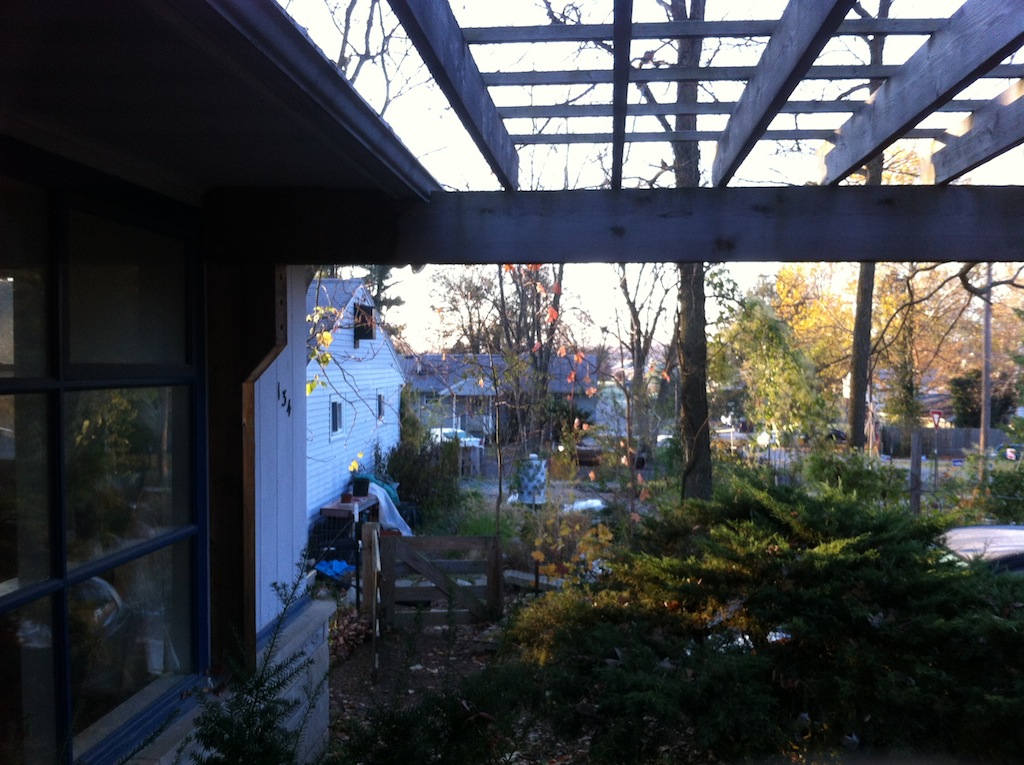
Looking from my porch, through the neighborhood garden (GANG) across DeKist to the house where a young man was shot and later died last Saturday night.
The tragic events of two nights ago make it even more imperative that we begin to think of our neighborhoods in new ways. Especially here in college towns where so many of us live near student “party houses,” mostly rentals, with absentee landlords.
This morning, I came across a video, on “Village Towns.” Here’s the blurb about it:
“A VillageTown is a 10,000 population
town made up of 20 villages. Within
there are no cars, it has its own
local economy, and its purpose is to
enable its citizens to enjoy a “good life”,
understood as the social pursuits of
conviviality, citizenship, artistic,
intellectual & spiritual growth.”
Great! I thought. Let’s go! This could be a great way to introduce the idea of showing how Green acres could become an actual functioning, at least quasi-self-sufficient village, networked inside a web of other self-sufficient neighborhood villages, each with its own character and charm and way of life, and all of them integrated into the dense web of life we call Bloomington, Indiana.
I couldn’t have been more wrong. Instead, this little video appears to be one more developer’s dream, focusing on “from the ground up” building of what look essentially, to me, like Disney villages, theme parks. Yuck! I couldn’t even bring myself to finish it.
Here’s the question that has haunted me for the last ten years: Why build new infrastructure when we can change perceptions in our existing neighborhoods?
Rather than chucking the built environment, starting over from scratch and using even more of Earth’s resources, let’s change our perceptions of living where we actually do live! Yes, even here, in this college town where students stream through every year, or two, or four, texting on their phones, or listening through earbuds, walking to and from IU on our Green Acres streets blind to the fact that they actually live in a neighborhood with others.
Green Acres is a typical Bloomington core neighborhood: 66% of the houses in Green Acres are registered rentals — mostly to students.
Let’s help our students learn how to redirect their energies from loud, mindless, all-night parties and the accompanying trouble that invites (see this) and instead focus their boundless energy where it counts: on growing food; on changing zoning laws to get small businesses back in neighborhoods; on working for strong public transportation and bike paths everywhere; on helping elders and children stay in the neighborhood together; on creating common spaces in which we can gather, on feeling safe. All of us.
As the students stream through our villages, they pick up another way of life, one which hearkens back to their great grandparents, before they were born, when people helped each other out, when they knew lots of skills — gardening, sewing, mending, fixing, tinkering — and passed them on to the young ones. And when they would gather, in living rooms and on porches, over bonfires, to tell stories, to find out about each others’ lives, all the while knitting a closely woven sense of being in this together, this little life of ours, this one that caught us up in the glamorous, glittery illusion of individualism and greedy materialism for far too long and that is now swinging back home, big time.
Some of these students might even decide to stick around when their college years are over. Start families. In the past two years, I’ve seen young mothers with strollers and buggies walking through Green Acres. If we’re very very lucky, this trend will continue. Green Acres might again be a place where children run in packs through the neighborhood, ignoring property lines and fences, hanging out in trees, playing hopscotch on the streets, slowing down cars to offer them lemonade from homemade stands . . .
Remember that?
Let’s place our feet where they are actually planted, right here at home. Relocalization begins in the household, then with our next door neighbors, and with others on our blocks, moving out from there. Who are your neighbors? Get to know them. You might need each other some day.
For much more on visioning Green Acres as a village, click on GANE.
Pingback: Geez! What’s going on in my neighborhood? | Exopermaculture
Pingback: Fractured Wrist Chronicles continues: Tear Down to Build Up, plus torture device | Exopermaculture
Pingback: Juxtaposing polarities . . . | Green Acres Neighborhood Association